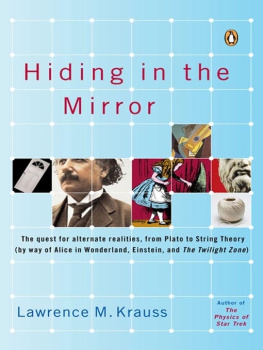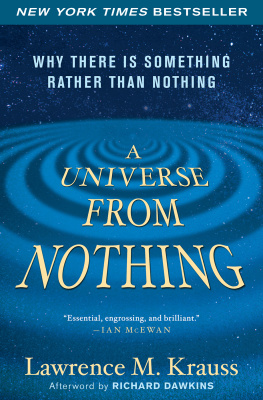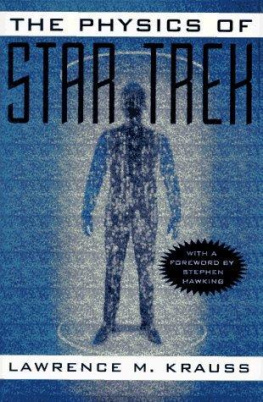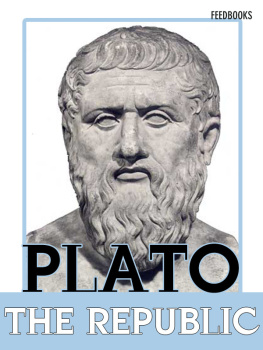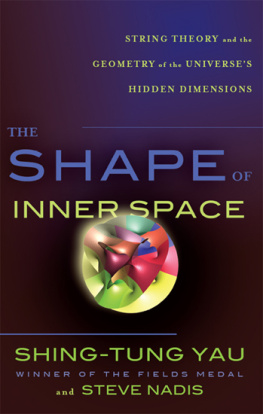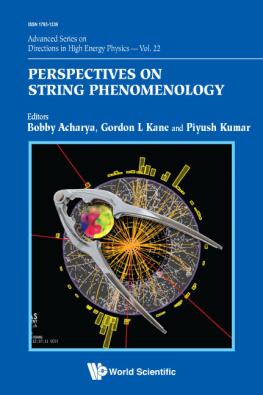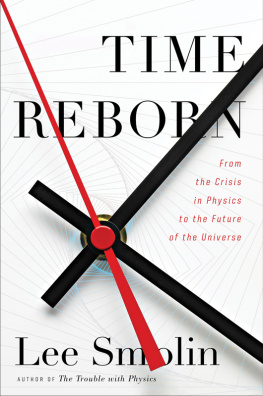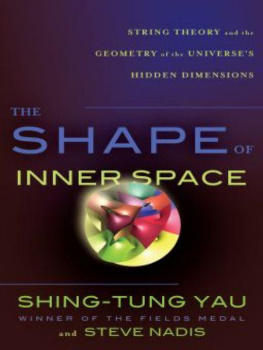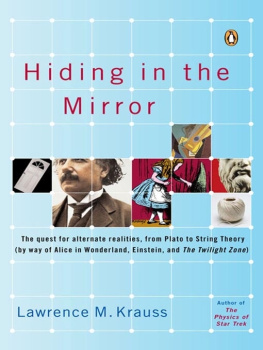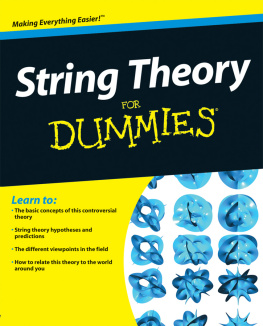Krauss - Hiding in the mirror : the mysterious allure of extra dimensions, from Plato to string theory and beyond
Here you can read online Krauss - Hiding in the mirror : the mysterious allure of extra dimensions, from Plato to string theory and beyond full text of the book (entire story) in english for free. Download pdf and epub, get meaning, cover and reviews about this ebook. City: New York, year: 2005, publisher: Viking,Penguin Books, genre: Science fiction. Description of the work, (preface) as well as reviews are available. Best literature library LitArk.com created for fans of good reading and offers a wide selection of genres:
Romance novel
Science fiction
Adventure
Detective
Science
History
Home and family
Prose
Art
Politics
Computer
Non-fiction
Religion
Business
Children
Humor
Choose a favorite category and find really read worthwhile books. Enjoy immersion in the world of imagination, feel the emotions of the characters or learn something new for yourself, make an fascinating discovery.
- Book:Hiding in the mirror : the mysterious allure of extra dimensions, from Plato to string theory and beyond
- Author:
- Publisher:Viking,Penguin Books
- Genre:
- Year:2005
- City:New York
- Rating:4 / 5
- Favourites:Add to favourites
- Your mark:
- 80
- 1
- 2
- 3
- 4
- 5
Hiding in the mirror : the mysterious allure of extra dimensions, from Plato to string theory and beyond: summary, description and annotation
We offer to read an annotation, description, summary or preface (depends on what the author of the book "Hiding in the mirror : the mysterious allure of extra dimensions, from Plato to string theory and beyond" wrote himself). If you haven't found the necessary information about the book — write in the comments, we will try to find it.
Hiding in the mirror : the mysterious allure of extra dimensions, from Plato to string theory and beyond — read online for free the complete book (whole text) full work
Below is the text of the book, divided by pages. System saving the place of the last page read, allows you to conveniently read the book "Hiding in the mirror : the mysterious allure of extra dimensions, from Plato to string theory and beyond" online for free, without having to search again every time where you left off. Put a bookmark, and you can go to the page where you finished reading at any time.
Font size:
Interval:
Bookmark:
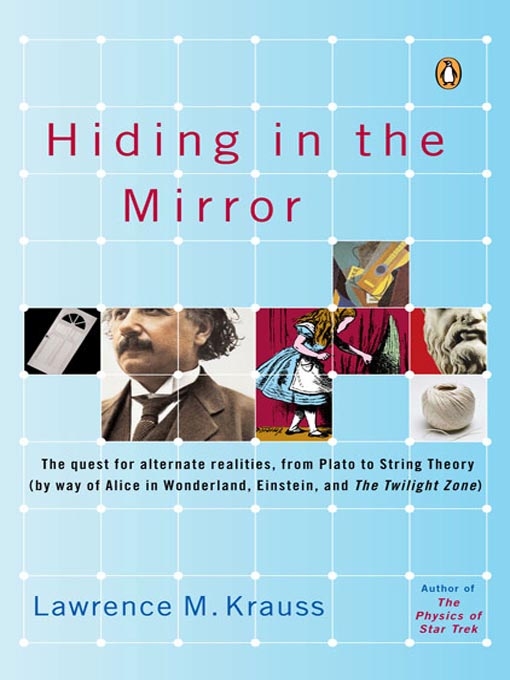
Why sir, there is everypossibility that you will soon be able to tax it!
Michael Faraday to Gladstone when asked aboutthe usefulness of electricity
The scientificrealization that space and time might not be quite what they seememerged from the unlikeliest of places: the nineteenthcenturylaboratory of a former bookbinders apprentice turned chemist, thenphysicist, tucked away in the heart of London, over fifty yearsbefore Edward Abbott penned his mathematical romance of manydimensions.
Michael Faraday was a common man with anuncommon passion. In his lifetime he refused both a knighthood andthe presidency of the Royal Society, preferring to remain, in hiswords, just plain Michael Faraday.
Perhaps his humble background forced him todevelop an uncommon intuition about nature or at least an uncommonability to develop pictorial explanations of natural phenomena thatcould bring otherwise lofty mathematical notions down to earth.Indeed, he claimedno doubt sarcasticallyto have written down amathematical equation only once in his lifetime. Whatever itsorigin, he had an inherent predisposition against theoreticalmodels that strayed even slightly beyond the constraints ofexperiment. It is thus ironic that Faraday ultimately provided theimpetus for the creation of one of the greatest theoreticalgeneralizations in the history of physics, a key that unlocked adoor to a hidden universe. That key took a form no one could haveanticipated in advance, and involved an act of serendipity in anexperiment in a laboratory full of chemicals, wires, batteries, andmagnets.
The experiment itself was disarmingly simple. Acloth-covered wire wrapped around one-half of a metal ring wasconnected to a switch connected to a battery. Another similar wirewas wrapped around the other half, but hooked up to a device thatcould detect the flow of electric current through the wire. Sincethe two different wires were not in direct contact and the clothwrapping insulated them from the metal ring, when the switch wasclosedcausing a current to flow in the first wirethere was noimmediate reason to have expected a current to flow in the second.But to his amazement, Faraday discovered that at the preciseinstant that the first switch was closed, or opened again, andonly in the instant when electric currenteither began or ceased to flow in the first wire, an electric currentwas mysteriously observed to flow in the second.
The uninitiated reader will at this point haveat least two questions: (1) Why on earth did Faraday set up such aweird experiment in the first place? and (2) What has this got to dowith space and time? The answers will require us to do some timetraveling of our own.
Over half a century before Plato pennedThe Republic, the Greek playwrightEuripides had coined the name magnets forthe odd lumps of ore found in the Greek province of Magnesia. Themysterious attraction of these objects to bits of iron fascinatedthe Greeks as it has fascinated generations of budding scientistsin each of the twenty-six centuries since then. The Greeks alsodiscovered another invisible force, one between amber (when rubbedwith fur) and bits of wood or fabric. This force did not receiveits modern name for almost twenty centuries, however, until in 1600the British scientist William Gilbert adapted the Greek word foramber, electrum, to its modern form,electric, to describe this strangeattraction. Following Gilberts own studies, electricity andmagnetism became the objects of intense scientific interest over thenext two centuries. Electricity yielded to a simple mathematicaldescription first, although it would take almost 170 years beforethe nature of electric forces between charged objects was fullydescribed. Red herrings, priority disputes, false leads, andtheories without experimental basis all complicated the search fora fundamental understanding of these forces, as they sometimes doin science. The Journal de Physique wrotein 1781 words that seem disarmingly familiar in a currentcontext:
Never have so many systems, so many newtheories of the Universe, appeared as during the last fewyears.
One of the more colorful episodes in this sagainvolved two brilliant Italian scientists, Allesandro Volta andLuigi Galvani. The subject of the great debate between these twoinvolved nothing less than frogs legs. Galvani had discovered, in1786, that electrical discharges could cause the leg of a dead frogto convulse. Ultimately, he was even able to make them convulse,simply by touching two different metallic plates to the frogsnerves. Galvani assumed that this metallic arc released someinherent electricity within the frog itself. Meanwhile, Volta, whohad developed sensitive instruments to detect the flow of electriccharge, felt instead that somehow the electricity was produced bythe contact of the two different metals. Ultimately, he was able toprove that this was in fact the cause of the dancing frogs, butmore importantly, in the process he developed the electric battery,which introduced a valuable new tool for both science andtechnology. In 1800 the American expatriate Count Rumford foundedthe Royal Institution in London and appointed thetwenty-three-year-old chemist Humphrey Davy as its director. In thebasement of this building Davy built a huge battery, based onVoltas principles, which he used to power a host of groundbreakingchemical experiments.
Davy was an imposing figure in British science,and his chemical experiments attracted the attention of scientistsand laymen alike. One of these, a young bookbinders apprentice,was fascinated with science and devoted his leisure time to itsstudy. After attending a series of lectures given by Davy, MichaelFaraday bound his carefully prepared notes in a volume andpresented them to the great man, with a humble request to beconsidered for the position of Davys laboratory assistant. In alesson that many students have since learnednamely, it never hurtsto flatter your teacherFaraday was rewarded with the job of hisdreams in that very year, 1813.
Meanwhile, on the Continent, strange newobservations were underway that began to illuminate an intriguinghidden connection between the otherwise diverse phenomena ofelectricity and magnetism. It had long been suspected, given thevarious resemblances between electricity and magnetism (likecharges repel, while opposite charges attract, just as two north ortwo south poles of magnets repel, while opposite poles attract,etc.), that perhaps these two forces were related in some fashion.In the same year that Faraday joined the Royal Institution asDavys assistant, Danish physicist-poet Hans Christian Oersted setout a challenge to himself and others to demonstrate thatelectricity and magnetism were indeed related. His quest wasrewarded seven years later when he published a remarkablediscovery: When an electric current flowed through a wire, it couldchange the orientation of a nearby compass. Oersted had discoveredthat electricity, when it flows, could generate magnetism. It isdifficult to describe the excitement that reverberated throughoutEurope when Oersted announced his findings in a short paper, whichwas translated into various European languages from Latin withinweeks. The day it was published in England, Davy brought it down tothe laboratory and began working immediately to reproduce itsresults. Twenty-five years later Faraday reminisced about therepercussions of Oersteds work:
It burst open the gates of a domain inscience, dark till then, and filled it with a flood of light. Onceagain, its the image of moving from darkness to light.
The intense intellectual activity throughoutEurope following the publication of Oersteds research was suchthat within several weeks the eminent French mathematician andphysicist Andr-Marie Ampre developed a remarkable theory of howelectricity could produce magnetism, which he later namedelectrodynamics. Based on a small amount of experimentation and alot of guesswork and speculation, Ampres original ideas werescattershot, but within a year or two they had come together toform the well-known theory that is quoted in physics textbookstoday: Ampre reasoned and demonstrated that if currents runningthrough wires could create magnets, and if magnets attracted orrepelled, then two nearby wires with currents flowing in them shouldbe repelled or attracted, depending upon the relative directions ofthe two currents.
Font size:
Interval:
Bookmark:
Similar books «Hiding in the mirror : the mysterious allure of extra dimensions, from Plato to string theory and beyond»
Look at similar books to Hiding in the mirror : the mysterious allure of extra dimensions, from Plato to string theory and beyond. We have selected literature similar in name and meaning in the hope of providing readers with more options to find new, interesting, not yet read works.
Discussion, reviews of the book Hiding in the mirror : the mysterious allure of extra dimensions, from Plato to string theory and beyond and just readers' own opinions. Leave your comments, write what you think about the work, its meaning or the main characters. Specify what exactly you liked and what you didn't like, and why you think so.

